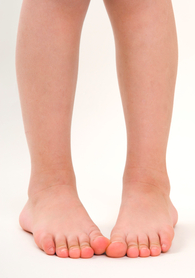In-Toeing & Out-Toeing: Should My Child’s Feet Be Pointing That Way?
January 29, 2019

Kids are constantly surprising us as they grow. They learn quickly, are constantly developing, growing and getting stronger – and not to mention wiser! But how do we know what is and isn’t normal when it comes to their feet and legs?
This is a question we get asked a lot here at Perform Podiatry. Especially when it comes to feet that are pointed inwards or outwards! Unfortunately, there is no one right answer, as it very much depends on the age of your kids and any other symptoms they may be experiencing. To help you better understand what’s going on and if what you’re seeing may be concerning, here’s our low-down on in-toeing and out-toeing for kids.
Note: If you’re an adult that is significantly in-toeing or out-toeing, that typically isn’t ‘normal’ and may be having consequences on your bones, joints and the rest of your body. If that sounds like you then we highly recommend coming in for an assessment with one of our expert Podiatrists.
If the out-toeing or in-toeing does not resolve on its own, we’re able to implement techniques to help encourage the feet to straighten. This can be done through:
Out-Toeing
Out-toeing describes the outwardly turned position of the feet that is sometimes referred to as ‘duck feet’. Out-toeing is less common than in-toeing, but it can be more serious if it doesn’t resolve. Out-toeing can be caused by:- The outward rotation of the femur (thigh bone)
- The outward position of the hip (present at birth)
- The outward rotation of the tibia (shin bone)
- Flat feet (which make the feet appear to point outwards)
In-Toeing
In-toeing describes the position where the feet are turned inwards to face one another when walking. It is often referred to as being ‘pigeon-toed’. While variations in foot position is not uncommon for young children, the in-toeing should resolve by the age of five years old. If it doesn’t, this is an indicator that the feet may need some assistance in straightening. In-toeing can be caused by:- Metatarsus adductus, which is a bean-like shape of the foot present at birth (approximately affecting 1 in 1000 births)
- The inward rotation of the femur (thigh bone)
- The inward rotation of the tibia (shin bone)
 How can these foot positions be treated?
How can these foot positions be treated?
If the out-toeing or in-toeing does not resolve on its own, we’re able to implement techniques to help encourage the feet to straighten. This can be done through:
- Orthotics that are custom-designed for the specific foot to encourage it to turn inwards or outwards respectively to straighten
- Strong, supportive footwear that will help stabilise the new position of the foot
- Stretching exercises to loosen tight muscles that may be affecting regular foot function
- Strengthening weak muscles to help maintain good foot positioning and alignment
